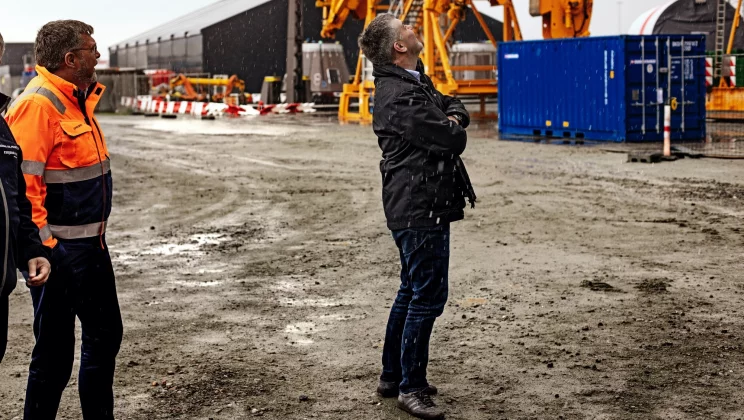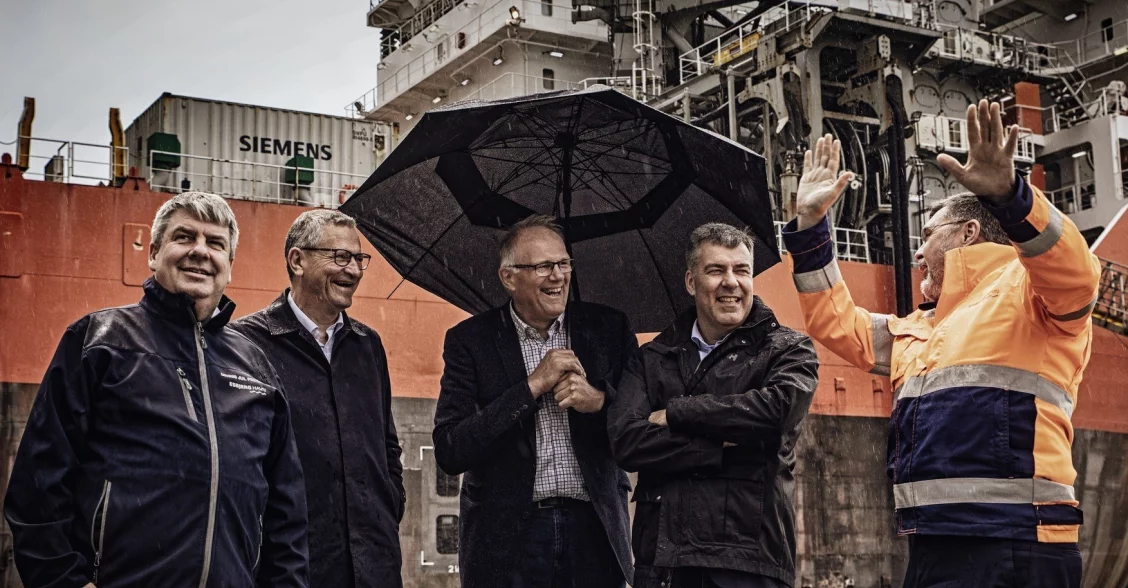Port Esbjerg will play an increasingly important role as new green technologies are rolled out. This was the key message from Lars Aagaard, Minister for Climate, Energy and Utilities, as he called on Port Esbjerg to take a closer look at the latest developments a few days before the elections for the European Parliament.
As the minibus turned to join a transport road, the passengers found themselves surrounded by 98-metre turbine blades lined up on both sides of the road.
“What we’re looking at right now is the largest accumulation of wind turbine components ever at a global level,” said Jesper Bank, CCO of Port Esbjerg, and he continued:
“The turbines produced over the next few years will be 110 to 120 metres long. Soon we’ll no longer be able to use this road.”
On the bus was Lars Aagaard, Danish Minister for Climate, Energy and Utilities, and he was impressed by the spectacle. Although this was not his first visit to the port, he was taken aback by the huge progress made since his last visit:
Turbines more than 100 metres long, nacelles weighing over 400 tonnes and with a capacity to produce 15MW on top of a wide range of other activities requiring expansion of the port area.
“As we grow in scale, the value chain will become too small. And then we need to reinvest,” said Port Esbjerg CEO Dennis Jul Pedersen from the front seat, evoking nods of approval from the Minister and two fellow party members accompanying the Minister on his visit to the port.
Value creation begins at local level
The background to the Minister’s visit and tour of the port was his wish to see the green transition in practice – a process driven by all the international players operating at and from the port though it creates growth and jobs primarily in and around Esbjerg.
While more than 7,500 people are already working at the port, additional resources are called for to fulfil the ambition of shipping more than 4.5 GW of offshore wind annually within just a few years. Qualified labour is a key element of the green transition.
“When we agreed with the industry in 2022 to establish training facilities at the port, it was on the condition that the students at the local vocational schools would be permitted to do their training and strengthen their skills here,” said Jul Pedersen.
Impressed, the Minister commented:
“There’s no doubt that Port Esbjerg is a key player in the green transition – internationally but also locally – thanks to the many jobs it creates.”
Responsibility comes with obligations
The notorious westerly winds and showers threatened to disrupt the tour but at the last minute seemed to decide to be kind, and the participants went on to inspect the large installation ships, the huge warehouses and cranes with lifting capacity in excess of 2,000 tonnes. Wind turbine components are more than twice as large and heavy today as they were ten years ago.
Port Esbjerg’s new role as a NATO port has not only made it necessary to expand the port area, it has also brought new responsibilities. The designation as a NATO port not only involves an obligation for Port Esbjerg to contribute to Europe’s safety but also requires the port to make space available for vehicles and equipment, and its ambitions extend beyond the expansion already completed and the ongoing deepening of the fairway:
“Naturally, we want to contribute as much as we can. Ideally, we would like to expand the airport to include a full hub with cargo facilities, for example,” said Jul Pedersen.

The Minister was very impressed by the tour around the port.
Demand for hydrogen
While the port is already buzzing with activity related to various forms of renewable energy, more is needed for Denmark’s green transition to succeed. Accordingly, in April, the Minister launched plans for a new hydrogen agreement that will potentially create a hydrogen “backbone” through Jutland with capacity to supply green hydrogen to our European neighbours.
“Our plans to establish a hydrogen pipeline could make Esbjerg a key player as a hub for the production of green hydrogen. I spoke to Robert Habeck (German Minister for Economic Affairs and Climate – ed.) last week. He’s very interested in purchasing green hydrogen from Denmark, but no final decisions have been made yet,” said Aagaard.
An agreement could help realise the green hydrogen potential faster and create an independent industry:
“PTX is a promising technology with great potential. But we need to provide the right incentives to speed up investments,” said Jul Pedersen.
So, ambitions are high, but various hurdles need to be cleared first.
Challenges that need to be solved
Action is required if we want to meet the ambitious targets for the green transition in Europe. With the elections for the European Parliament only two days away, the Minister laid out the challenges:
“The planned offshore wind tender needs to be more transparent – for the benefit of the entire value chain,” he said.
Securing Europe’s energy supply has been a clear guiding principle of the North Sea Cooperation, headed by Lars Aagaard since the beginning of the year:
“We’ll present our recommendations to the new Commission. We need to be able to look as far ahead as 2030 and 2040. This may seem like a very long timeframe, but for some – like Port Esbjerg – this is absolutely crucial,” said Aagaard, and as the bus turned into the parking lot overlooking the impressive port, reaching the end of the tour, the port’s CEO supported his view:
“We need more investments. And to secure that, we need much better conditions for planning ahead,” concluded Jul Pedersen.
Go to overview

